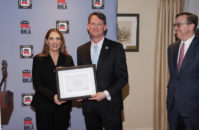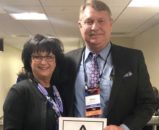The rebirth of Missouri’s automotive industry and the creation of thousands of new jobs has been a cornerstone of the Governor’s administration
COLUMBIA, Mo. – Gov. Jay Nixon today received the Motor & Equipment Manufacturers Association’s 2016 State Leadership Award. The award, which recognizes his work for making the motor vehicle industry and job creation a priority during his seven years in office, was presented to the Governor in Columbia at MEMA member company Dana Incorporated.
“I am honored to accept this award on behalf of the 24,000 men and women working the line every day in Missouri to build the best cars, trucks, motors and parts in the world,” Gov. Nixon said. “Because of the action we took and the investments we’ve made, next-generation vehicles and parts will be made right here in Missouri for many, many more years to come.”
“Gov. Nixon has shown us how visionary leadership can have an impact on real jobs,” said MEMA President and CEO Steve Handschuh. “We’re pleased to recognize his promotion, leadership and record of support for our industry.”
Gov. Nixon has made job creation in the motor vehicle industry one of his top priorities during his tenure. After taking office in 2009, his first act as Governor was to create an Automotive Jobs Task Force to make recommendations on creating new investments on behalf of the industry.
As a result of his initiatives, motor vehicle manufacturers and suppliers have invested more than $2 billion in Missouri, with 24,000 motor vehicle-related jobs and more than 16,000 direct automotive plant and supplier jobs. In addition, 64 automotive plant and parts suppliers in Missouri have announced expansions in recent years, including the recently announced $39 million expansion at the Dana facility in Columbia, which is expected to create 135 new jobs. MEMA members have some 65 facilities in Missouri, including Bosch, Continental, Dana, Faurecia, Federal Mogul, Haldex, Johnson Controls, Inteva, Lear, Magna, Spartan Light Metal, SRG and Tenneco.
The automotive industry is a $4 billion industry in Missouri, representing 18 percent of Missouri’s exports, and automotive suppliers, manufacturers, and dealers are located in nearly every county. Under Gov. Nixon’s leadership, the Automotive Jobs Task Force recommended that Missouri create an environment supportive of new automotive technologies and enhance state resources dedicated to providing auto-related workers with the skills required in a rapidly-changing global industry.
In addition, the task force recommended that state resources be used to assist automotive companies in diversifying their sales, upgrading their technological capabilities, increasing their long-term viability, and focus efforts on identifying reuse opportunities for vacant automotive production facilities.
In 2010, Gov. Nixon called a special session of the General Assembly to support and strengthen Missouri’s automobile manufacturing and supplier industry. That special session resulted in the bi-partisan passage of the Missouri Manufacturing Jobs Act, which curbed job losses in the industry and positioned Missouri to compete for next-generation auto jobs.
In 2013, Missouri also created its premier incentive program Missouri Works, lowering the threshold for smaller businesses to access benefits for creating as few as two jobs. This program has been instrumental in helping several dozen auto supply companies leverage expansions, resulting in job retention and creation throughout the state.
Gov. Nixon has also been a strong supporter of additional funding for education programs to focus on science, technology, engineering, and math skills. These critical skills are needed as today’s workforce produces advanced-vehicle technologies that improve safety, reducing emissions, and increasing mobility through connected vehicles. Over his administration, nearly $98 million in training funds have helped hundreds of companies implement next-generation workforce training programs. Overall, these companies have been able to train nearly 300,000 workers as well as hire and train an additional 10,000 workers for newly created jobs.






